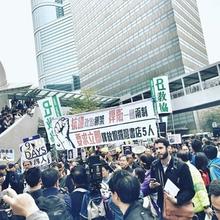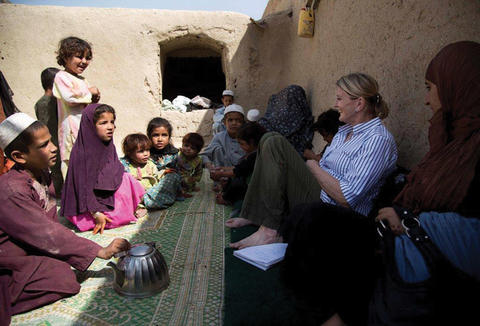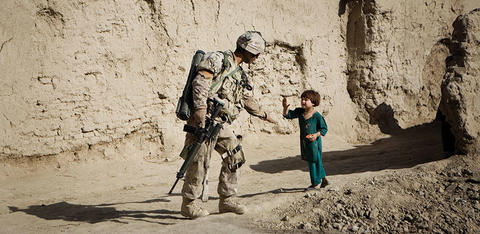The challenges of foreign correspondence today.
By Giovanna Dell'Orto
In a world of unprecedentedly fast and widespread connectivity—not only through technology, but also globalization and migration—the question of how we form images of people and issues beyond our borders has never been more essential. Instantaneous communication has shrunk time and distances, but it certainly has not bridged cultural and ideological divides: Fighters for the Islamic State, after all, also post selfies with kittens.
With an ever-growing body of information (and misinformation) available in the online free-for-all, journalists—professionals working for independent media organizations whose goal is to serve a general audience, not political or commercial interests—are positioned to be irreplaceable mediators between ordinary citizens and policymakers and the greater world. But just when reporters who gather foreign news have never been more necessary, they are also more endangered than ever on all fronts. That urgency has compelled Murphy Hall researchers to study their practices and impacts.
With many media organizations in a financial tailspin, budget cuts have dramatically curtailed foreign newsgathering. When journalists can afford to get on the ground, they are often targeted with increasingly pervasive violence, especially in the places that pose some of the most vital threats to the global order, from terrorism to drug and human trafficking. The Committee to Protect Journalists estimates (conservatively) that 1,228 journalists were killed while doing their jobs between 1992 and the end of 2016.
And then there is the question of what effect journalism can have, given how news consumption has changed. Sixty-two percent of American adults now get their news on social media (mostly Facebook), according to the Pew Research Center. That means that their news feed from Mexico—to use a neighboring country, with profound, multifaceted ties to the United States as an example—is a jumble where a friend’s snapshot of tacos in Cancún pushes past a straight-news account about cartel wars. No wonder that only 32 percent of Americans say they have “a great deal” or “a fair amount” of trust and confidence in the mass media “to report the news fully, accurately and fairly”—historical lows, according to a September 2016 Gallup poll.
From my master’s thesis (defended at the School of Journalism and Mass Communication in 2000) to my latest book, AP Foreign Correspondents in Action: WWII to the Present, I have studied how foreign news—both the content and the practices that shape it—affect foreign policymaking. Two colleagues who joined the SJMC team in fall 2016, professors Valerie Belair-Gagnon and Colin Agur, have just released their research about the use of new technologies in foreign newsgathering.
Media and Foreign Policy
There has long been a scholarly debate over whether journalists function as watchdogs or lapdogs to foreign policymaking elites. My research takes a different approach to studying how media affect the ways policy gets made, arguing that news helps turn foreign issues into understandable realities with specific meanings, which then are taken for granted in the policy process. In American Journalism and International Relations (Cambridge University Press, 2013), I analyzed more than 2,000 news articles about 20 major international events from 1848 to 2008. I found that news narratives of the world and, just as importantly, of the United States’ role in it, helped define the parameters within which Americans, including policymakers, thought about the world, and sometimes, crucially, provided the chance to think outside the box.
That’s why robust, independent foreign coverage is necessary. Not only does it disseminate information and context in order to make rational policy debate feasible, but it also counters the ability of political and other actors to control which narratives about the world dominate public discussion. But there is a bitter paradox: While bottom line-minded, Twitter-trend-conscious executives at many media organizations cut spending on foreign news, there are plenty of others—from authoritarian regimes to terror groups to local mafias—who do not doubt the value of quality journalism to informed citizenry, and they prove it by doing their absolute violent worst to silence and censor journalists. Why? Because the only way to get accurate, impactful stories out to billions of people daily is for correspondents to be eyewitnesses with enough contextual knowledge to challenge simplistic narratives and call out the omnipresent lies.
To do so, correspondents face a maze of hurdles at all stages, from figuring out what’s the story to audience reaction—and the two are connected by the tension between what correspondents can see on the ground as an important story, and what they know will appeal to a general audience, as I learned after interviewing 61 foreign correspondents with the Associated Press—the wire service that, while rarely studied, has dominated foreign news in the United States over the past eight decades. A core practice in foreign correspondence is to find sources; to get people in the highest and lowest strata of a foreign society to tell their story on the record. That’s fraught with dangers, for the correspondents and for those who dare speak to them.
Faced with both budget cuts and physical dangers, many journalists have turned to social media, particularly chat apps like the vastly popular WhatsApp (which has more than one billion monthly active users), to find and interact with sources such as undocumented migrants or political activists on the move. Belair-Gagnon, Agur and their New Frontiers in Newsgathering report co-author, Nicholas Frisch, studied chat app use by foreign correspondents based in Hong Kong and China during and since the 2014 Umbrella Movement, which protested proposed changes to Hong Kong’s electoral laws. The journalists, with the help of “digital fixers” attuned to cultural nuances and languages who provided ad-hoc assistance managing data, did gain multimedia access to protesters, sometimes evading China’s notorious digital surveillance. But these new platforms also raise questions about how news organizations can verify content, identify echo chambers and navigate fake news, especially given the increasing pressures on journalists to report quickly and at a distance.
Journalists, of course, also try to give a voice to those who are not on Facebook, people whose very faces might never be seen in public. That’s what AP senior correspondent for Pakistan and Afghanistan Kathy Gannon and Pulitzer-winning AP photographer Anja Niedringhaus did when they traveled to Taliban-controlled Kandahar in 2013 to interview survivors of a murderous rampage by a U.S. soldier—including the women who would not have been allowed to travel to the relative safety of Kabul to speak with reporters. As Gannon later told me, “If you don’t hear their voices, you don’t know them. If you don’t know them, you don’t understand them. If you don’t understand them, you can’t engage. That’s the whole reason why we tell any story, I think, or cover any area, is to know the people.”
The Dangers of News Gathering
But that kind of journalism on the ground carries tremendous risks. Less than a year after I talked with them in Islamabad, Niedringhaus was killed and Gannon gravely injured when an Afghan officer shot them as they waited inside a police compound to accompany a convoy of electoral workers on the eve of Afghanistan’s national elections. From Syria to Mexico, correspondents driven by the imperative to bear witness push against the limits of areas that violence against journalists has made into no-go zones.
Above: Kathy Gannon, special regional correspondent for Pakistan and Afghanistan, interviews Masooma (sitting against the wall, fully covered in shawl), whose husband was one of 16 villagers killed by a rampaging American soldier, and chats with Masooma's children and nephews, in Kandahar, Afghanistan, on April 20, 2013. Photo by Anja Niedringhaus, courtesy of Kathy Gannon.
I asked former AP chief Middle East correspondent Terry Anderson, who was kidnapped in Beirut during the Lebanese war in the 1980s and held hostage for nearly seven years, whether running this gauntlet of devastating risks in the name of informing the public is worth it. Here’s what he told me.
"So where is the value in what we do? What we do is find and tell the truth as best as we can in situations where everybody is lying and it’s very difficult to do that and often dangerous to do that ... You have to believe in the inherent value of doing that, of telling the truth, of finding and telling the truth no matter what happens, whether people listened, whether things changed, whether anybody goes to jail, and sometimes they do, in order to understand and do this job, because then the ethics become simpler. Anything that keeps you from doing that is unethical, is wrong.... [A]sk the people who kill [journalists], beat them and put them in prison, whether it’s important, because they all know you cannot have a free society without a free press. Period. You cannot oppress the people, you can’t steal from them, you can’t take away their rights in the face of a free and active press, that’s why they go after the journalists, that’s why everybody hates journalists. No, we’re not all wonderful people, we’re not all even very good at the job we do, and there are constraints, institutional constraints, societal constraints that keep us from achieving this wonderful goal of finding and telling the truth, but most of the journalists that I know are highly idealistic people with a firm sense of outrage. They try to do that as best as they can. So yeah, I think it was worthwhile. I think it was worth doing."
As the death toll of journalists killed on assignment with full impunity keeps rising—and censorship, surveillance and manipulation of the flow of global information also increase, all exacerbating global security threats—the sword is, sometimes literally, asserting itself as mightier than the pen. Can anything be done?
I believe that the answer is yes. I tell SJMC students that, as consumers of media, our voices have never been heard more clearly by news executives. Virtually all major newsrooms constantly monitor every most emailed and retweeted item of news, scrutinizing which stories we’re reading or watching, how deeply and for how long. So let’s click on all the real foreign news we can find—from Afghanistan and Mexico and Hong Kong and anywhere else journalists (and their sources) are risking their lives or freedom to tell us what is happening. It won’t unlock a treasure trove of funding for news media, or keep the sword at bay. But just as it is for those whose stories journalists tell, recognition is the first protection.
Giovanna Dell’Orto (Ph.D. ‘04) is an Associate Professor at SJMC, where she teaches and researches the interplay between news, journalistic practices and international affairs, topics she has lectured about to academic and professional audiences from China to Chile. In addition to AP Foreign Correspondents in Action and American Journalism and International Relations, she is the author or editor of three other books on journalism and international affairs, including Reporting at the Southern Borders: Journalism and Public Debates on Immigration in the U.S. and the E.U. (Routledge, 2013). She is also the co-author of a book on press freedom in the American Civil War era with SJMC Professor Emerita Hazel Dicken-Garcia.


